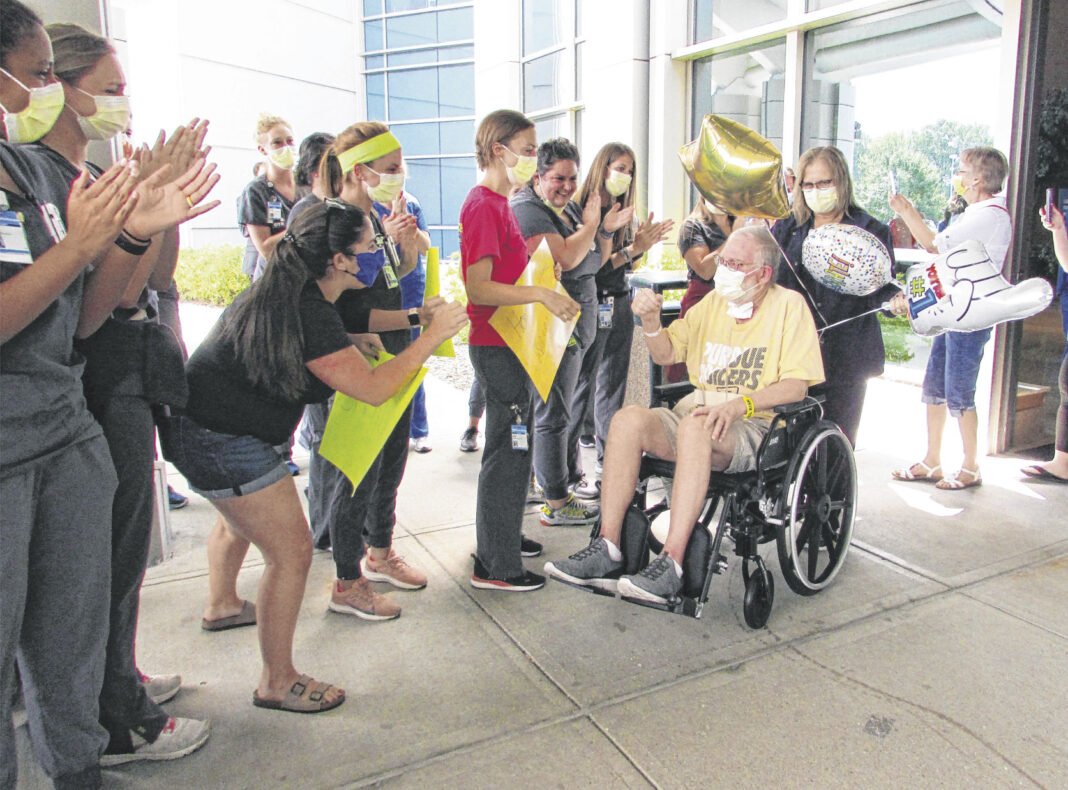The doctor’s urgent call came at 1:30 a.m., and the news was not good.
Kevin Coy’s family was summoned to Franciscan Health Indianapolis to discuss the Whiteland resident’s dire condition. His lungs had been ravaged by COVID-19, and one of the small sacs that exchanges oxygen into the blood had burst. The only hope was using a heart-lung machine that would circulate fresh oxygen-rich blood into his body, and even that was a long shot.
Be prepared for the worst, they were told.
“That was going to be the only thing that would save his life,” said Michelle Oldham, Coy’s daughter.
Slowly, his condition stabilized. Over the course of his five-month battle with COVID-19 and the damage it did to his body, Coy went from the emergency room to critical care. He was put on the lung-heart machine for a treatment known as extracorporeal membrane oxygenation, which required him to be in a medically induced coma so his lungs and heart could heal.
Doctors were wary he would survive. Even if he did, he’d likely need a lung transplant, they told his family. But Friday, Coy left Franciscan Health Indianapolis after four months in the hospital.
“I know there were hundreds and hundreds of people praying for me. God answered their prayers,” Coy said. “There’s no doubt the equipment they used saved my life, but I still feel like they were being guided by God.”
Holding out hope
Coy first started feeling fatigued in mid-March. Working in dry development at Eli Lilly, he thought maybe he was just tired and hoped it would get better. When it didn’t, he got a COVID-19 test.
He tested positive on March 28. His wife Sandy also took a test. It too was positive. Neither had not been vaccinated yet, but they both had appointments to get one in mid-April at Indianapolis Motor Speedway.
While they quarantined and rested, Sandy Coy lost her sense of smell and taste, but didn’t experience any worse symptoms.
But Coy’s condition deteriorated. In April, he was sick enough that he was admitted to the emergency room at Johnson Memorial Hospital, where he stayed for five days.
When his condition kept getting worse, his family took him to Franciscan Health Indianapolis for more advanced treatment.
“It was the right call. They have equipment here that they don’t have down there,” Coy said.
The equipment included the heart-lung machine, which they could use for extracorporeal membrane oxygenation. Blood is pumped outside the body to a heart-lung machine that removes carbon dioxide and sends oxygen-filled, rewarmed blood back to tissues in the body. The method allows the blood to “bypass” the heart and lungs so the organs can rest and heal.
As the coronavirus pandemic raged on, the treatment had emerged as a tool used for patients who had extreme cardiopulmonary distress due to the disease.
Coy was hooked to the heart-lung machine for 71 days, and his memory of much of that time is spotty or non-existent, due to being placed in a medically induced coma. The family couldn’t visit, so Oldham and her sister, Laura Wilson, would take turns calling each day to check on his condition.
“We’d get some stats and vitals, just to check on his progress. It was hard,” Oldham said.
Under the watch of Larry Garrison, the chief perfusionist in the cardiac vascular operating rooms, Coy continued to receive the extracorporeal membrane oxygenation.
“My family was basically told that some of the doctors felt like there wasn’t much more they could do, besides a lung transplant,” Coy said. “But (Garrison) saw something in all of the numbers where he still had some hope for me. So they agreed to let me stay on it.”
A ‘miracle’ recovery
Only after Coy tested negative for COVID-19 were family members permitted to see him again.
They watched over him while he was in the coma, until his condition stabilized to the point where he could be taken off the sedatives. Even then, it took weeks before he fully woke up.
He was so weak he couldn’t speak initially, and as much as his family tried to communicate with him, it was difficult. A whiteboard and stand helped solve the problem.
“At first, I was shaky and they had trouble reading my writing. But that got better after a while,” he said.
Throughout August, Coy regained strength as his lungs healed. Oldham has photos of lung scans taken in May, which show the organs clouded with white inflammation.
In comparison, scans from August are clearer and more healthy looking.
“His lungs were not supposed to improve. He was supposed to have a lung transplant to survive,” Oldham said.
Finally, this week, he received word from his doctors he could go home.
Coy has been at Franciscan Health so long he’s developed a deep connection with the doctors and nurses who kept him alive. They were present on Friday to see him leave their care; the ones who couldn’t be with him made arrangements to watch on video.
He is looking forward to enjoying his wife’s cooking again after months of hospital food. He’ll be in his own bed, in his own surroundings.
“We have a couple cats that I’m curious to see how they’ll react. You know how cats are anyway; they may be happy to see me, and they may wonder what I’m doing back,” he said.
Even as he leaves the hospital, Coy realizes his recovery has only just started. He moves with the assistance of a walker, but quickly gets winded. Therapists and nurses will still come to his house to help him. Sandy Coy has received her first dose of the COVID-19 vaccine, and Kevin Coy plans to get it when he can.
Still, he can feel his body healing.
“If I’m laying here or sitting in a chair, I don’t need oxygen,” Coy said. “Considering where I started, it’s a miracle.”





